
Österlånggatan
Encyclopedia
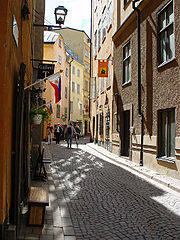
Street
A street is a paved public thoroughfare in a built environment. It is a public parcel of land adjoining buildings in an urban context, on which people may freely assemble, interact, and move about. A street can be as simple as a level patch of dirt, but is more often paved with a hard, durable...
in Gamla stan
Gamla stan
Gamla stan , until 1980 officially Staden mellan broarna , is the old town of Stockholm, Sweden. Gamla stan consists primarily of the island Stadsholmen. The surrounding islets Riddarholmen, Helgeandsholmen, and Strömsborg are officially part of, but not colloquially included in, Gamla stan...
, the old town of Stockholm
Stockholm
Stockholm is the capital and the largest city of Sweden and constitutes the most populated urban area in Scandinavia. Stockholm is the most populous city in Sweden, with a population of 851,155 in the municipality , 1.37 million in the urban area , and around 2.1 million in the metropolitan area...
, Sweden
Sweden
Sweden , officially the Kingdom of Sweden , is a Nordic country on the Scandinavian Peninsula in Northern Europe. Sweden borders with Norway and Finland and is connected to Denmark by a bridge-tunnel across the Öresund....
. Stretching southward from Slottsbacken
Slottsbacken
Slottsbacken is a street in Gamla stan, the old town in central Stockholm, Sweden.It stretches east from the Stockholm Cathedral and the Royal Palace down to the street Skeppsbron which passes along the eastern waterfront of the old town...
to Järntorget
Järntorget (Stockholm)
Järntorget is a small public square in Gamla stan, the old town in central Stockholm, Sweden. Located in the southernmost corner of the old town, the square connects the thoroughfares Västerlånggatan and Österlånggatan, while the two alleys, Södra Bankogränd and Norra Bankogränd, stretches east...
, it forms a parallel street to Baggensgatan
Baggensgatan
Baggensgatan is a street in Gamla stan, the old town in central Stockholm, Sweden. Forming a southern extension to the street Bollhusgränd near the square Köpmantorget, it stretches to the southern end of Svartmangatan...
and Skeppsbron
Skeppsbron
Skeppsbron is both a street and a quay in Gamla stan, the old town of Stockholm, capital of Sweden, stretching from the bridge Strömbron in front of the Royal Palace southward to Slussen....
. Major sights include the statue of Saint George and the Dragon
Saint George and the Dragon
The episode of Saint George and the Dragon appended to the hagiography of Saint George was Eastern in origin, brought back with the Crusaders and retold with the courtly appurtenances belonging to the genre of Romance...
on Köpmanbrinken
Köpmanbrinken
Köpmanbrinken is a street composed of two slopes, in Gamla stan, the old town in central Stockholm, Sweden. Both slopes connects the street Österlånggatan west up to the small Köpmantorget and the street Köpmangatan....
and the restaurant Den Gyldene Freden
Den Gyldene Freden
Den gyldene freden is a restaurant in the old town of Stockholm, Sweden. It's one of Sweden's most well-known restaurants and the oldest restaurant in the world to have the same surroundings, which is noticed in the Guinness book of records...
on number 51, established in 1722 and mentioned in Guinness Book of Records as one of the oldest with an unaltered interior.
History
Like VästerlånggatanVästerlånggatan
Västerlånggatan is a street in Gamla stan, the old town of Stockholm, Sweden. Stretching southward between the squares Mynttorget and Järntorget, it follows the course of the city's now demolished 13th century defensive wall....
, Österlånggatan used to pass outside of the city walls and was for many centuries one of the city's major streets. (See Västerlånggatan for more details.) When Skeppsbron
Skeppsbron
Skeppsbron is both a street and a quay in Gamla stan, the old town of Stockholm, capital of Sweden, stretching from the bridge Strömbron in front of the Royal Palace southward to Slussen....
, the broad street and quay running to the east of Österlånggatan, was created during the 17th century, Österlånggatan lost much of the importance it used to have. Compared to Västerlånggatan, Österlånggatan is today a relatively quiet street notwithstanding the many restaurants and shops, in sharp contrast to the neighbourhood when the street formed the backyard of the dock district, crowded with sailors, taverns, travellers, and traders.
During the 13th century, Österlånggatan was little more than the eastern shoreline, and archaeological excavations have unveiled the original beaten track some three metres below today's pavement. The shore line was, however, gradually pushed eastward by land fillings of gravel and rubbish. In the 14 century, the street had become the 'long street east of the wall' (e.g. Österlånggatan), far from the water, paved and lined-up with workshops, shops, and dwellings. German merchants lived in and around Järntorget
Järntorget (Stockholm)
Järntorget is a small public square in Gamla stan, the old town in central Stockholm, Sweden. Located in the southernmost corner of the old town, the square connects the thoroughfares Västerlånggatan and Österlånggatan, while the two alleys, Södra Bankogränd and Norra Bankogränd, stretches east...
, while Swedish merchant's from Bergslagen
Bergslagen
Bergslagen is a historically, culturally, and linguistically distinct mining district located north of Lake Mälaren in northern Svealand, Sweden. In Bergslagen mining and metallurgic industry have been important since the Middle Ages...
, the mining district north of the capital, resided on Österlånggatan, and only a few of the noble families settled here during the Middle Ages. One of them was Gunilla Johansdotter Bese (1473–1553), who lived in the now closed alley still carrying her name, Fru Gunillas Gränd
Fru Gunillas Gränd
Fru Gunillas Gränd is a historical alley in Gamla stan, the old town in central Stockholm, Sweden, once connecting Skeppsbron to Österlånggatan between Johannesgränd and Packhusgränd....
, between Numbers 43 and 45.
Many taverns from 17th century are known in the street: Riga on Number 19; Holländska Dyn ("Dutch Slough") on Number 21; Förgylda Draken ("Gilded Dragon") on Number 27; Tre Kungar ("Three Kings") on Number 28; Sveriges Wapen ("Swedish Arms") on Number 29; and Stjärnan ("The Star") in the Rococo
Rococo
Rococo , also referred to as "Late Baroque", is an 18th-century style which developed as Baroque artists gave up their symmetry and became increasingly ornate, florid, and playful...
building on Number 45. Of all these taverns, only Den Gyldene Freden
Den Gyldene Freden
Den gyldene freden is a restaurant in the old town of Stockholm, Sweden. It's one of Sweden's most well-known restaurants and the oldest restaurant in the world to have the same surroundings, which is noticed in the Guinness book of records...
("The Golden Peace") on Number 51 remains, but can hardly give a hint of the filth, stench, rows, and misery once hidden behind the romantic names.
The shipping trade gradually disappeared and by the early 20th century virtually everything associated with it on Österlånggatan was gone. Since the 1980s, the street have gradually been transformed into a quiet shopping street.
Slottsbacken - Köpmanbrinken
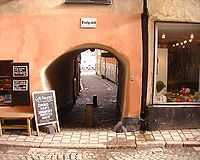
Slottsbacken
Slottsbacken is a street in Gamla stan, the old town in central Stockholm, Sweden.It stretches east from the Stockholm Cathedral and the Royal Palace down to the street Skeppsbron which passes along the eastern waterfront of the old town...
it can be hard to even discover, and as the narrow northern end is squeezed between tall façades, its easy to misinterpret the street as yet another of the many alleys. The first block is, however, flanked by two buildings worth a brief note: On the right side is the rear face of the Royal Coin Cabinet
Royal Coin Cabinet
The Royal Coin Cabinet is a museum located on Slottsbacken, Gamla Stan, in central Stockholm, Sweden, dedicated to the history of money.It is an institution with a national responsibility for the conservation and the historical studies of coins, medals, and finance in general...
, housing a royal collection begun in the 16th century, and on the left is Number 1, a building started in 1897 and completed in 1950 to the plans of Ivar Tengbom
Ivar Tengbom
Ivar Justus Tengbom was a Swedish architect and one of the best-known representatives of the Swedish neo-classical architecture of the 1910s and 1920s....
(1878–1968), more famous as the architect behind Stockholm School of Economics
Stockholm School of Economics
The Stockholm School of Economics or Handelshögskolan i Stockholm is one of Northern Europe's leading business schools. Its Masters in Management program is ranked no. 2 in Northern Europe and no. 13 in Europe by the Financial Times...
and Stockholm Concert Hall
Stockholm Concert Hall
The Stockholm Concert Hall is the main hall for orchestral music in Stockholm, Sweden. Designed by Ivar Tengbom and inaugurated in 1926, it is the home to the Royal Stockholm Philharmonic Orchestra. It is also where the awarding ceremony for the Nobel Prizes, Polar Music Prize are held annually....
— the windows facing Telegrafgränd
Telegrafgränd
Telegrafgränd is an alley in Gamla stan, the old town of Stockholm, Sweden. Stretching from Skeppsbron to Österlånggatan, it is a parallel street to Slottsbacken and Skeppar Karls Gränd.- Origin of the name :...
, the first alley, gives a clear idea of what the building looked like at the time, in sharp contrast to the 18th-century stone portal on the opposite side of the alley.
The first façade of Number 3-7 dates back to the 1760s with many later additions, for example the large northern window was the same size as the small southern until the 1960s while its large 18th-century shutters show there once was a door here. In contrast, the plain façades of Number 5 and 7 have an old feeling but is mostly a product of a later restorations: in 1963 the old mouldings and two of the original four windows of N.5 where removed, and the door of N.7 was placed where the southern window now is until the mid 1930s. The second alley, Skeppar Karls Gränd
Skeppar Karls Gränd
Skeppar Karls Gränd is an alley in Gamla stan, the old town of Stockholm, Sweden. Stretching from Skeppsbron to Österlånggatan, it forms a parallel street to Telegrafgränd and Bredgränd....
is named after Skipper Karl who bought a building in the alley in the 16th century, the alley at the time facing the big fish market and the adjacent waterfront where his ships were moored.
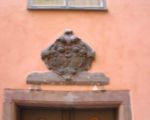
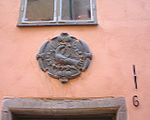
Bollhusgränd
Bollhusgränd is an alley in Gamla stan, the old town in central Stockholm, Sweden. Named after Bollhuset, a historical theatre, it connects Slottsbacken to Köpmantorget, and as Baggensgatan extends the alley further south beyond Köpmangatan, together they form a parallel street to Österlånggatan...
, while the 'modest' portal on this side carries the arm of Per Banér and Hebbla Fleming. On the façade is also the fire bird Phoenix
Phoenix (mythology)
The phoenix or phenix is a mythical sacred firebird that can be found in the mythologies of the Arabian, Persians, Greeks, Romans, Egyptians, Chinese, Indian and Phoenicians....
taking off surrounded by flames, the symbol of the fire insurance company created to tackle the fires frequently ravaging the old town, owned by its costumers and still residing on Mynttorget
Mynttorget
Mynttorget is a public square in Gamla stan, the old town in central Stockholm, Sweden.- Setting :From the square the bridge Stallbron leads over to the Parliament island Helgeandsholmen; to the west the street Myntgatan leads to Riddarhustorget, while the quay Kanslikajen stretches along the...
. The cartouche
Cartouche
In Egyptian hieroglyphs, a cartouche is an ellipse with a horizontal line at one end, indicating that the text enclosed is a royal name, coming into use during the beginning of the Fourth Dynasty under Pharaoh Sneferu, replacing the earlier serekh...
s are from the 17th century, while the portals and remaining façade is from the 18th century. Number 10-12 were merged in the 1760s when the top of the building was added and the building got much of its present appearance, save for the enlarged shop windows and some original decorations now gone.
In Number 9 is the vault of Bredgränd
Bredgränd
Bredgränd is an alley in Gamla stan, the old town of Stockholm, Sweden. Stretching from Skeppsbron to Österlånggatan, it forms a parallel street to Skeppar Karls Gränd and Kråkgränd.- Origin of the name :...
("Broad Alley"), not really wide viewed from Österlånggatan, but actually one of the wider in the opposite end. In the alley remains of the city wall from the late Middle Ages have been found, 2 metres wide at the base narrowing off towards the top, it was made of stone, brick and wood taken from timbered houses. Both plain façades of Number 11-13 date back to the 17th century and are largely unaltered since the 1870s, except for some joineries and minor details.
The alley Kråkgränd
Kråkgränd
Kråkgränd is an alley in Gamla stan, the old town of Stockholm, Sweden. Stretching between Skeppsbron and Österlånggatan, it forms a parallel street to Bredgränd and Nygränd....
, named after the magistrate
Magistrate
A magistrate is an officer of the state; in modern usage the term usually refers to a judge or prosecutor. This was not always the case; in ancient Rome, a magistratus was one of the highest government officers and possessed both judicial and executive powers. Today, in common law systems, a...
Knut Nilsson Kråka who lived there in the early 17th century. The alley have also been named after the magistrate Johan Persson who in 1638 took over a property said to be located "on the upper corner in a vault over the alley". Under the first five small building behind Number 15 are the merged medieval cellars of the restaurant Fem Små Hus ("Five Small Houses") started in 1969. The basement of the block have, however, served as a tavern for several hundreds years — two illegal inns were reported in 1694.
Köpmanbrinken
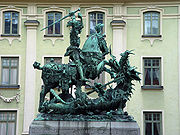
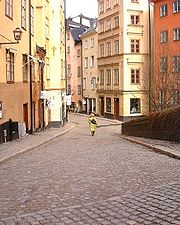
Köpmanbrinken ("Merchant's Slope") is leading up to Köpmantorget
Köpmantorget
Köpmantorget is a small public square in Gamla stan, the old town in central Stockholm, Sweden, located between the street Köpmangatan and to slopes collectively named Köpmanbrinken, both of who leads down to the street Österlånggatan...
, its railing featuring the statue of Saint George and the Dragon
Saint George and the Dragon
The episode of Saint George and the Dragon appended to the hagiography of Saint George was Eastern in origin, brought back with the Crusaders and retold with the courtly appurtenances belonging to the genre of Romance...
, a copy from 1912 of the original located in the Stockholm Cathedral
Storkyrkan
Sankt Nikolai kyrka , most commonly known as Storkyrkan and Stockholms domkyrka , is the oldest church in Gamla Stan, the old town in central Stockholm, Sweden. It is an important example of Swedish Brick Gothic...
. Where the statue is today there used to be an entire block triangular in shape. One of the three buildings it contained was used as a synagogue
Synagogue
A synagogue is a Jewish house of prayer. This use of the Greek term synagogue originates in the Septuagint where it sometimes translates the Hebrew word for assembly, kahal...
for a few years in the late 18th century, but as this collapsed on May 1, 1821, the entire block was demolished. Buildings collapsed somewhat frequently in the area as the underlying soil, composed entirely of land filling, slid eastward and pulled the layers of gravel under the buildings in the process. Also in 1821, a wall in 8 Köpmanbrinken, reported as "looking rather trustworthy", was however transformed into a ruin in a snap, flying debris smashing windows on the opposite side of the street.
On the opposite side, on either side of Number 17, are two relatively new alleys: Nygränd
Nygränd
Nygränd is an alley in Gamla stan, the old town of Stockholm, Sweden, connecting Skeppsbron to Österlånggatan.Old names : Niia grenden , Nygrenden...
("New Alley"), which notwithstanding the name is from the 16th century, and Brunnsgränd
Brunnsgränd
Brunnsgränd is an alley in Gamla stan, the old town in central Stockholm, Sweden. Connecting Skeppsbron to Österlånggatan, it forms a parallel street to Nygränd and Skottgränd...
("Well's Alley"), which notwithstanding the name contains no well. The explanation for this is former location of the biggest market square in Stockholm between these two alleys, called Fisketorget
Fisketorget
Fisketorget or Fiskaretorget is a historical public square in Gamla stan, the old town in central Stockholm, Sweden...
("Fisher's Square"). It stretched down from the city gate located where Köpmantorget
Köpmantorget
Köpmantorget is a small public square in Gamla stan, the old town in central Stockholm, Sweden, located between the street Köpmangatan and to slopes collectively named Köpmanbrinken, both of who leads down to the street Österlånggatan...
is today, to the waterfront between 1413 and around 1520. During the 14th century it was even named Fiskestrand ("Fishery Shore") and stretched north to Skeppar Karls Gränd
Skeppar Karls Gränd
Skeppar Karls Gränd is an alley in Gamla stan, the old town of Stockholm, Sweden. Stretching from Skeppsbron to Österlånggatan, it forms a parallel street to Telegrafgränd and Bredgränd....
. The well beneath the statue of Saint George (both created in 1912) is often erroneously associated with Brunnsgränd, but the well which gave the alley its name is found inside the block north of it.
The present building on Number 17 is the design of the architect Carl Malmström. Built in 1902 and inspired by the building on 10 Skeppsbron (possibly by Nicodemus Tessin the Younger
Nicodemus Tessin the Younger
Count Nicodemus Tessin the Younger was a Swedish Baroque architect, city planner, and administrator.The son of Nicodemus Tessin the Elder and the father of Carl Gustaf Tessin, Tessin the Younger was the middle-most generation of the brief Tessin dynasty, which have had a lasting influence on...
), it featured shops on street level, flanked by pilaster
Pilaster
A pilaster is a slightly-projecting column built into or applied to the face of a wall. Most commonly flattened or rectangular in form, pilasters can also take a half-round form or the shape of any type of column, including tortile....
s topped by volute
Volute
A volute is a spiral scroll-like ornament that forms the basis of the Ionic order, found in the capital of the Ionic column. It was later incorporated into Corinthian order and Composite column capitals...
s, offices on the second floor behind the low rounded arches and the bar windows, with dwellings above and storage below. Originally, the entrance was flanked by two minor doors facing the street (the door still is still there), and was slightly more elaborated. The green colour of the building would have pleased neither of the two architects, but obviously was to the taste of today's catering business, judging from the restaurant residing there - Pontus in the Green House.
Köpmanbrinken - Benickebrinken
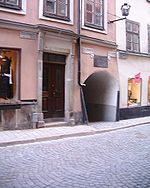
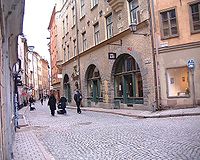
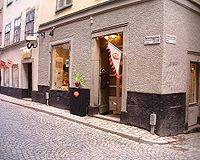
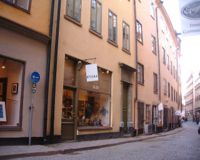
Baggensgatan
Baggensgatan is a street in Gamla stan, the old town in central Stockholm, Sweden. Forming a southern extension to the street Bollhusgränd near the square Köpmantorget, it stretches to the southern end of Svartmangatan...
.
While the sandstone on ground level of number 19 is 18th century in style, it was unveiled in the 1960s, the building however received much of its present appearance in 1876. During the following decades, the proprietors then started to add and relocate the doors of the building, sealing one door to replace a window with a new door, ten years later reverting the arrangement — in many aspects typical for the faith of the buildings in the old town. The building was occupied by the tavern Riga
Riga
Riga is the capital and largest city of Latvia. With 702,891 inhabitants Riga is the largest city of the Baltic states, one of the largest cities in Northern Europe and home to more than one third of Latvia's population. The city is an important seaport and a major industrial, commercial,...
during the 17th and 18th century, and during 60 years from 1917 by a sail loft. South of Number 19 is Skottgränd
Skottgränd
Skottgränd is an alley in Gamla stan, the old town of Stockholm Sweden, stretching from Skeppsbron to Österlånggatan.Old names : Skottegrändenn , østan till Skåttegrändhenn...
, an alley named after the Scotsmen who settled here in the 17th century, supposedly to own their living either as merchants or warriors. On Number 2 was the tavern Bacchus in the early 18th century, Number 6 was a storage as the still operational derrick show, and over the door of Number 3 is the inscription NON DOMUS DOMINUM SED DOMINUS DOMUM, roughly: 'A dominion doesn't make a lord, but a lord makes a domesticity'. One of the two shuttered windows on the southern side has iron detailing 17th century in style, but both of them are from 1873 when the façade of Number 21 was completed together with its portal feature featuring sculptural leaf garland and ductile wooden decorations. Next to the vault leading to Stora Hoparegränd
Stora Hoparegränd
Stora Hoparegränd is an alley in Gamla stan, the old town of Stockholm, Sweden. Connecting Skeppsbron to Österlånggatan, it forms a parallel street to Skottgränd and Drakens gränd....
(a name derived from hooper
Hooper
The word hooper is an archaic English term for a person who aided in the building of barrels by creating the hoop for the barrel. Hooper may also refer to:Place names in the United States:...
, the profession of making barrels) is just enough space for the narrow front door of Number 23; the portal of which is 18th century in style but was added to the building probably in the mid-19th century, a few decades before the shop door got flanked by its fluted wooden pilasters.
The imposing old building on the opposite side, Number 14, featuring an oriel
Oriel
An oriel window is a type of bay window which projects from a wall.Oriel may also refer to:Places in the United Kingdom:*Oriel College, Oxford*Oriel Street, Oxford*Oriel Square, Oxford*Oriel Chambers, LiverpoolPlaces in Ireland:...
, a Renaissance frieze, and a Baroque portal was built in 1888 to the design of Isak Gustaf Clason
Isak Gustaf Clason
Isak Gustaf Clason was a Swedish architect.- Biography :Clason studied engineering and later architecture at the Institute of Technology in Stockholm, where he was a student of A. T. Gellerstedt, and later at the architectural school of the Academy of Arts, at the time headed by Fredrik Wilhelm...
, an architect known for the uninhibited use of historical styles from various epochs for different commissions — the 'Nordic Renaissance' of the Nordic Museum
Nordic Museum
The Nordic Museum is a museum located on Djurgården, an island in central Stockholm, Sweden, dedicated to the cultural history and ethnography of Sweden from the Early Modern age until the contemporary period...
on Djurgården is arguably the best example. The façade, unaltered except for the pediments over the doors removed in 1966, was inspired by the buildings of the old town, and the eclectic pioneering style of the architect is regarded as a first decisive step away from the well-established manners of the 19th century to rebuild old structures using the cast iron constructions introduced throughout the city during this time (see Riddarholmskyrkan
Riddarholmskyrkan
The Riddarholmen Church is the burial church of the Swedish monarchs. It is located on the island of Riddarholmen, close to the Royal Palace in Stockholm, Sweden. The congregation was dissolved in 1807 and today the church is used only for burial and commemorative purposes. Swedish monarchs from...
). The façade is full of quotations from various historical periods, together humbly adapting to the heterogeneous environment, while the large stone vaults are adjusting the relation between the street and the interior.
The façades of Number 25-27 are insidiously similar in appearance. The first have been repeatedly rebuilt — old doors removed, windows enlarged, the plain plastered surface added in the early 20th century, and the concrete portal in the 1970s — while the rough-cast façade and stone portal of the other is overall 18th century in character and largely unaltered since 1757. Not much different is Number 16 on the opposite side of the street, the four cast iron pilasters and the fair-faced plaster of which is unaltered since 1889, while there was originally a depressed rounded arch over the double sliding doors of the front door.
Between Drakens Gränd
Drakens Gränd
Drakens Gränd is an alley in Gamla stan, the old town of Stockholm, Sweden. Stretching from Skeppsbron to Österlånggatan, it forms a parallel street to Stora Hoparegränd and Ferkens Gränd....
and the vault of Ferkens Gränd
Ferkens Gränd
Ferkens Gränd is an alley in Gamla stan, the old town of Stockholm, Sweden, connecting Skeppsbron to Österlånggatan. It forms a parallel street to Drakens gränd, Lilla Hoparegränd, Pelikansgränd, and Gaffelgränd....
(named after the German word for pig, Ferkel) is Number 29-31; the stone pilasters, double doors, and simple profiled borders of the former are from 1850, while the latter is much unaltered since it was enlarged in 1834, as with many other building the shop windows have been enlarged during the 19th and 20th centuries. Much due to the shutters and plain stone portals of Number 18 on the opposite side, this façade have kept its simple character since the 18th century when the building served as an outhouse (e.g. a shed), even though the door shutters were added in the 19th century and the doors are from the 1970s.
While Number 33 is probably much the product of a paring which removed the moulding and detailing from 1939, the light 18th-century character of the fair-faced plaster façade and its narrow doors and windows is left pretty intact. In contrast, the dark and rough surface of Number 35, which probably reflects the appearance of the façade in 1778, hardly gives a hint of the three small original windows facing the street, or the shop window installed in 1916, wider than the present, notwithstanding the fact the main door is 18th century in style. Similarly, the narrow Gustavian wooden portal, most likely from 1777, on Number 20 on the opposite side, gives the entire façade a simple and ancient character, but gives no hint of the three round arched wall openings depicted on an elevation in 1852 when the top floors of the building were added. And again, Number 22 have kept much of its simple appearance from the 18th century, notwithstanding the large shop windows of the gallery, most likely from the mid- or late 19th century.
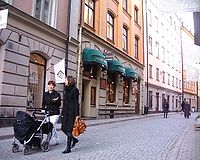
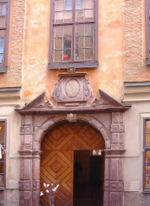
Lilla Hoparegränd
Lilla Hoparegränd is an alley in Gamla stan, the old town of Stockholm, Sweden. Passing between Skeppsbron and Österlånggatan, it forms a parallel street to Ferkens Gränd, Gaffelgränd, Pelikansgränd, and Johannesgränd....
("Smaller Heaper's Alley", a corruption of "Hoper's Alley", e.g. hooper
Hooper
The word hooper is an archaic English term for a person who aided in the building of barrels by creating the hoop for the barrel. Hooper may also refer to:Place names in the United States:...
indicating a profession, 'maker of barrels') and Pelikansgränd
Pelikansgränd
Pelikansgränd is an alley in Gamla stan, the old town of Stockholm, Sweden, connecting Gaffelgränd to Österlånggatan...
("Pelican's Alley"), both forking off from Gaffelgränd
Gaffelgränd
Gaffelgränd is an alley in Gamla stan, the old town of Stockholm, Sweden, connecting Skeppsbron to Lilla Hoparegränd and Pelikansgränd, both of which are leading to Österlånggatan....
("Fork alley"). While the building is standing on a medieval wall, the façade is from the 18th century, and the portal from the 17th century. The latter was probably cut by Johan Wendelstam, a German sculptor who arrived to Stockholm in 1641 to became the Guild Master within a few years, and also cut one of the portals on Stortorget
Stortorget (Stockholm)
Stortorget is a small public square in Gamla Stan, the old town in central Stockholm, Sweden. It is the oldest square in Stockholm, the historical centre around which the medieval urban conglomeration gradually came into being...
. The client was apparently Dutch as the inscription on the gable stone
Gable stone
Gable stones are carved and often colourfully painted stone tablets, which are set into the walls of buildings, usually at about 4 metres from the ground. They serve both to identify and embellish the building...
reads: Gaet het wel men heeft veel vrinden kert het luck wie kan se vinden ("When luck stands by one have a lot of friends, but when luck turns where are they then?"). Behind the front door is an entrance hall featuring a richly profiled sandstone column carrying a cross-vault. The façade of Number 24 dates back to 1862, the shutters and wooden panels from that time however replaced by the rough-cast plaster probably in 1945, and the windows enlarged since. The rusticated façade of Number 26 dates back to the enlargement in 1846, at the time it was however perfectly symmetric, a balance manipulated in 1973 when the enlarged opening and wooden panel of the restaurant entrance was added. The northern door, still featuring some original details, gives a fair impression of what the façade looked like in the 19th century. The façade of Number 28, arguably one of the oldest still existent residential properties in Stockholm, is mostly from 1874 with some details replaced in 1969.
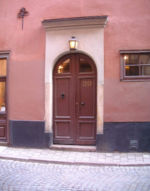
Sten Sture the Elder
Sten Sture the Elder was a Swedish statesman and regent of Sweden from .-Background:...
transferred the lot now forming the southern part of the façade to the Order of Saint John
Knights Hospitaller
The Sovereign Military Hospitaller Order of Saint John of Jerusalem of Rhodes and of Malta , also known as the Sovereign Military Order of Malta , Order of Malta or Knights of Malta, is a Roman Catholic lay religious order, traditionally of military, chivalrous, noble nature. It is the world's...
, which had a church built here, inaugurated in 1514, and demolished in 1530 following the Reformation
Protestant Reformation
The Protestant Reformation was a 16th-century split within Western Christianity initiated by Martin Luther, John Calvin and other early Protestants. The efforts of the self-described "reformers", who objected to the doctrines, rituals and ecclesiastical structure of the Roman Catholic Church, led...
. A wall from and the graveyard of this church was rediscovered under the alley Johannesgränd
Johannesgränd
Johannesgränd is an alley in Gamla stan, the old town of Stockholm, Sweden, connecting Skeppsbron to Österlånggatan....
passing south of the block; King Gustav Vasa
Gustav I of Sweden
Gustav I of Sweden, born Gustav Eriksson of the Vasa noble family and later known simply as Gustav Vasa , was King of Sweden from 1523 until his death....
is known to have looted the graveyard to assemble raw material to produce saltpetre
Potassium nitrate
Potassium nitrate is a chemical compound with the formula KNO3. It is an ionic salt of potassium ions K+ and nitrate ions NO3−.It occurs as a mineral niter and is a natural solid source of nitrogen. Its common names include saltpetre , from medieval Latin sal petræ: "stone salt" or possibly "Salt...
used for gunpowder, a deed commented: "Not Christian is thus shoot one's forefathers in the air" (Ej är kristeligt i väder så skjuta sina förfäder).
Benickebrinken-Järntorget
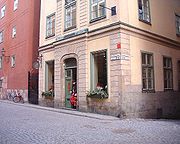
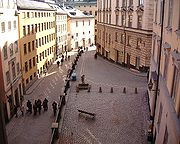
Northern and southern Benickebrinken
Benickebrinken
Södra/Norra Benickebrinken are two sloping streets in Gamla stan, the old town in central Stockholm, Sweden, stretching from Österlånggatan up to Svartmangatan....
("Slope of Benicke") leading up to Svartmangatan ("Black Man's Street") are named after the innkeeper Jören Benick who in the middle of the 16th century ran a tavern here named Solen ("The Sun") after the symbol hanging in the street. His tavern was located in a block demolished in the 19th century which used to run between Österlånggatan and the two then extremely narrow slopes. The tavern was preceded by the Blackfriars monastery located south of the slopes 1330s-1520s, the graveyard of which was discovered under the southern slope, while the extent of it is still marked by two lines of paving stones in Prästgatan
Prästgatan
Prästgatan is a street in Gamla stan, the old town in central Stockholm, Sweden, stretching from a cul-de-sac west of the Royal Palace to the street Österlånggatan in the southern corner of the old town. Prästgatan forms a parallel street to Västerlånggatan, Trångsund, Skomakargatan, and...
passing south of the block.
An archaeological excavation in 2000 in the block behind Number 47-51 have revealed several foundation works of old buildings and of the second city wall (15th-16th century) and one of its defensive towers, a corner of which was located in the alley Packhusgränd
Packhusgränd
Packhusgränd is an alley in Gamla stan, the old town of Stockholm, Sweden. Stretching west from Skeppsbron to Österlånggatan, it forms a parallel street to Johannesgränd and Tullgränd....
passing north of the block. The troubadour Carl Michael Bellman
Carl Michael Bellman
was a Swedish poet and composer. Bellman is a central figure in the Swedish song tradition and remains a very important influence in Swedish music, as well as in Scandinavian literature in general, to this day....
often used living individuals as prototypes for the numerous people appearing in his Bacchanalian songs, and the model for Ulla Winblad
Ulla Winblad
Ulla Winblad was a semi-fictional character in many of Carl Michael Bellman's works. Ulla Winblad was, or at least inspired by, Maria Kristina Kiellström .Ulla Winblad was described as a goddess of sex, worshiped and adored, but not respected...
, a promiscuous woman, was Maria Kristina Kiellström
Maria Kristina Kiellström
Maja Stina Kiellström was a Swedish silk manufacturer and alleged prostitute. She inspired Carl Michael Bellman to create his character, the prostitute "Bar-Nymph", demimonde, and courtesan Ulla Winblad....
who took the name Winblad ("Wine leaf") from her stepmother. While its not known how well acquainted she was with Bellman, she did marry his friend Erik Nordström with whom she settled in Norrköping
Norrköping
Norrköping is a city in the province of Östergötland in eastern Sweden and the seat of Norrköping Municipality, Östergötland County. The city has a population of 87,247 inhabitants in 2010, out of a municipal total of 130,050, making it Sweden's tenth largest city and eighth largest...
in 1772. As her husband died in custody, she moved back to Stockholm in 1782 and settled on Number 47. In the meantime the songs of Bellman had made her famous and everyone was charmed by her return to the capital. She was less flattered however, and it is said she gave Bellman a blow at one occasion and her second husband is reported to have regularly complained he had married that 'lecherous woman'. Her reaction is somewhat understandable, considering the often burlesque lyrics in the songs. Below are 3 of the 21 verses of his 48th epistle named Varuti avmålas Ulla Winblads hemresa från Hessingen i Mälaren en sommarmorgon 1769 ("In which is depicted Ulla Winbladh's journey home from Hessingen in Lake Mälaren
Mälaren
Lake Mälaren is the third-largest lake in Sweden, after Lakes Vänern and Vättern. Its area is 1,140 km² and its greatest depth is 64 m. Mälaren spans 120 kilometers from east to west...
a summer's morning 1769"), describing the trip back to Stockholm from Stora Essingen
Stora Essingen
Stora Essingen is an island and a district in the Kungsholmen borough in Stockholm, Sweden. The Essingeleden motorway, part of European route E4, passes along a section of the eastern shore...
in a rowing boat passing by Marieberg where at the time was located a saltpetre work and a penitentiary.
| Ulla, fästman på dig ser. | Ulla, your fiancé is looking at you. |
| Kom, min Norströms lilla, | Come, my darling of Norstöm's, |
| sätt dig brevid mej, sitt ner, | sit by my side, sit down, |
| fritt din låga stilla! | let your flare freely fade! |
| Vi har alla lika rang. | We are all of equal rank. |
| Lustigt! Hör basuners klang! | Amusing! Hear trumpets blast! |
| Prosit och contentement! | Bless you and contentment! |
| Dyrbar ögonvila. | Dear delightful sight. |
| [...] | [...] |
| Såg du nu Marieberg, | Now, did you notice Marieberg, |
| så se längre neder; | then look further down; |
| med en gul och bleknad färg | yellow and pale in colour |
| sig ett tjäll utbreder. | extends a humble abode. |
| Fönstren glittra. Kännen I | Glittering windows. Smell thou |
| ej salpetersjuderi? | not the saltpetre works? |
| En gång, Ulla — raljeri! — | Some day, Ulla — raillery! — |
| palten dit dig leder. | bobby will take you there. |
| [...] | [...] |
| Norström stjälper sin peruk | Norström tips his wig |
| av sin röda skalla, | off his red pate, |
| och min Ulla, blek och sjuk, | and my Ulla, faint and ill, |
| lät sin kjortel falla, | let her skirt fall, |
| klev så bredbent i paulun; | thus straddle-legged stepped into bed; |
| Movitz efter med basun: | Movitz after with the trumpet: |
| maka åt dig, Norström! Frun | get away, Norström! The lady |
| hör ju till oss alla. | do belong to all of us. |
On Number 51 is the restaurant Den Gyldene Freden
Den Gyldene Freden
Den gyldene freden is a restaurant in the old town of Stockholm, Sweden. It's one of Sweden's most well-known restaurants and the oldest restaurant in the world to have the same surroundings, which is noticed in the Guinness book of records...
("The Golden Peace"), named after the Treaty of Nystad
Treaty of Nystad
The Treaty of Nystad was the last peace treaty of the Great Northern War. It was concluded between the Tsardom of Russia and Swedish Empire on 30 August / 10 September 1721 in the then Swedish town of Nystad , after Sweden had settled with the other parties in Stockholm and Frederiksborg.During...
in 1721 and in opened in 1722, it remains the oldest and most famous restaurant in Sweden. Carl Michael Bellman use to work in the Custom House on the opposite side and while he is likely to have visited the place occasionally, he is not likely ta have been a regular there. He is however associated with the establishment, and he actually saved it from being closed down more than a hundred years after his death. The society preserving his memory, Bellmans minne ("Memory of Bellman"), meet regularly in the restaurant and when the painter Anders Zorn
Anders Zorn
Anders Leonard Zorn was one of Sweden’s foremost artists who obtained international success as a painter, sculptor and printmaker in etching.-Biography:...
at one of their sessions in February 1919, was told the old restaurateur was about to retire and would discontinue the business, Zorn bought for SEK
Swedish krona
The krona has been the currency of Sweden since 1873. Both the ISO code "SEK" and currency sign "kr" are in common use; the former precedes or follows the value, the latter usually follows it, but especially in the past, it sometimes preceded the value...
150,000, had it restored for SEK 250,000, and later bequeathed it to the Swedish Academy
Swedish Academy
The Swedish Academy , founded in 1786 by King Gustav III, is one of the Royal Academies of Sweden.-History:The Swedish Academy was founded in 1786 by King Gustav III. Modelled after the Académie française, it has 18 members. The motto of the Academy is "Talent and Taste"...
together with a requirement the latter should appoint the members of a foundation which should manage the property and use the annual yield to award a prominent poet the prize Bellmanpriset.
An archaeological excavation in 1993, in the intersection with Prästgatan
Prästgatan
Prästgatan is a street in Gamla stan, the old town in central Stockholm, Sweden, stretching from a cul-de-sac west of the Royal Palace to the street Österlånggatan in the southern corner of the old town. Prästgatan forms a parallel street to Västerlånggatan, Trångsund, Skomakargatan, and...
and Tullgränd
Tullgränd
Tullgränd is an alley in Gamla stan, the old town of Stockholm, Sweden, connecting Skeppsbron to Österlånggatan. It forms a parallel street to Packhusgränd and Norra Bankogränd....
just south of Södra Benickebrinken, unveiled a bricked wall 0,5 metres under the current street. This section of Österlånggatan used to be much narrower, and the wall is what remains of a building once located on Number 34-36 on the western side of the street, demolished together with a triangular block located between Österlånggatan and the two slopes north of the intersection when the southern part of the street was widened in 1898. The building was known as Kyskendal ("Chastity Valley"), described as a "Cupid
Cupid
In Roman mythology, Cupid is the god of desire, affection and erotic love. He is the son of the goddess Venus and the god Mars. His Greek counterpart is Eros...
's tempel filled with priestesses from basement to attic", while the basement was the location for the tavern Krypin ("Creep/Crawl-In"), mentioned by C M Bellman in his 23rd epistle.
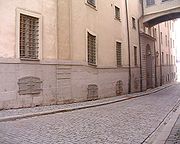
Parliament of Sweden
The Riksdag is the national legislative assembly of Sweden. The riksdag is a unicameral assembly with 349 members , who are elected on a proportional basis to serve fixed terms of four years...
in 1906. The window gratings on ground level and the small windows above still reminds of its former function. The defective foundation works caused huge crevices in fronts facing the alley, and while the damaged have been repaired, there are still windows inclined windows in the alley as a reminder. The small portal facing Österlånggatan is from the early 19th century. An arched passage over Norra Bankogränd
Norra Bankogränd
Norra Bankogränd is an alley in Gamla stan, the old town of Stockholm, Sweden. Connecting Skeppsbron to Österlånggatan and Järntorget, it forms a parallel street to Tullgränd and Södra Bankogränd....
connects the building to Södra Bankohuset
Södra Bankohuset
Södra Bankohuset or Gamla Riksbanken is a building in Gamla stan, the old town of Stockholm, Sweden, together with Norra Bankohuset the location of the Bank of Sweden until 1906...
, the former main building of the national bank facing Järntorget
Järntorget (Stockholm)
Järntorget is a small public square in Gamla stan, the old town in central Stockholm, Sweden. Located in the southernmost corner of the old town, the square connects the thoroughfares Västerlånggatan and Österlånggatan, while the two alleys, Södra Bankogränd and Norra Bankogränd, stretches east...
.
See also
- List of streets and squares in Gamla stan
- Fru Gunillas GrändFru Gunillas GrändFru Gunillas Gränd is a historical alley in Gamla stan, the old town in central Stockholm, Sweden, once connecting Skeppsbron to Österlånggatan between Johannesgränd and Packhusgränd....
External links
- http://www.hitta.se/SearchCombi.aspx?__VIEWSTATE=%2FwEPDwUKMTg4NDI3NTMzNWRk&UCSB%3AWflWhite=1a1b&UCSB%3AWflPink=4a&SearchType=4&UCSB%3ABBX1=&UCSB%3ABBY1=&UCSB%3ABBX2=&UCSB%3ABBY2=&UCSB%3ATextBoxWho=&UCSB%3ATextBoxWhere=%D6sterl%E5nggatan+Stockholm&UCSB%3AButtonSearch=%A0%A0hitta%21%A0%A0&CombiDetails%3AMapControl%3Acx=1628856&CombiDetails%3AMapControl%3Acy=6580586&CombiDetails%3AMapControl%3ApointsHidden=&CombiDetails%3AMapControl%3Az=3hitta.se - Location map and virtual walk]
- Stockholm City Museum - Shop façades consensus 2002-2003
- Stockholmskällan - Historical photos

